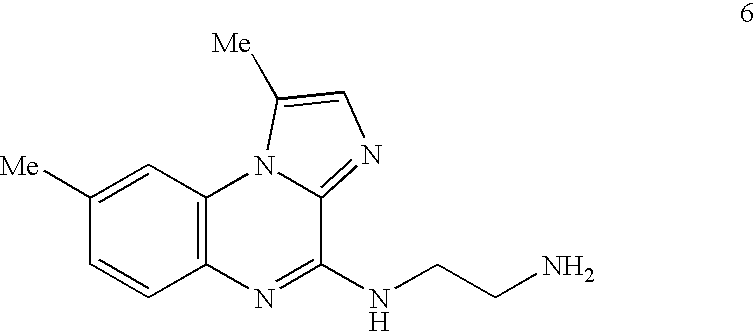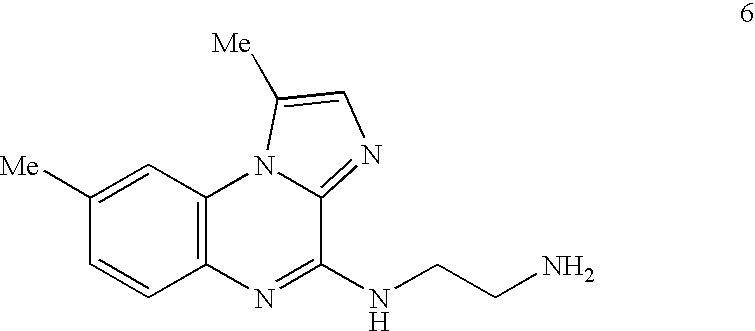Methods of treating inflammatory and immune diseases using inhibitors of IkappaB kinase (IKK)
a technology of ikappab and kinase, which is applied in the direction of immunodeficiency syndrome, drug composition, biocide, etc., can solve the problems of complex interaction mechanisms, inability to show anti-inflammatory or immunodeficiency effects of inhibitors of ikk-1 and/or ikk-2, and inability to inhibit disease in vivo, etc., to achieve effective oral bioavailability and assess the bioavailability of inhibitor compounds
- Summary
- Abstract
- Description
- Claims
- Application Information
AI Technical Summary
Benefits of technology
Problems solved by technology
Method used
Image
Examples
example 1
Method of Preparation of IKK Inhibitor 4(2'-aminoethyl)amino-1,8-dimethyl---imidazo(1,2-a)quinoxaline (Compound 6)
[0177] The IKK inhibitory compound 4(2'-aminoethyl)amino-1,8-dimethylimida-zo(1,2-a) quinoxaline, or compound 6 newly described herein, can be prepared by a method as described in the following scheme. Starting materials are commercially available or can be readily prepared by one of ordinary skill in the art, and / or modifications can be made to the method of the scheme by one skilled in the art, using known methods and practices.
[0178] Chemical Scheme for Preparing Compound 6 9
[0179] Compound 6 or 4(2'-aminoethyl)amino-1,8-dimethylimidazo(1,2-a) quinoxaline, can be prepared as shown in the above scheme: 3-fluoro-4-nitrotoluene (compound 1) is reacted with ethyl 5-methylimidazole-4-caboxylate (compound 2) according to known procedures to produce, after several steps, the imidazoquinoxalone-2-carboxylic acid (compound 3). Upon decarboxylation of said acid (compound 3) in ...
example 2
Analysis of Inhibitory Potential of IKK Inhibitors, Using 4(2'-Aminoethyl)amino-1,8-dimethylimidazo(1,2-a)quinoxaline (Compound 6)
[0195] IKK-1 / IKK-2 Enzyme Assay
[0196] Assays for measuring the inhibitory potential of test compounds, specifically compound 6, (4(2'-aminoethyl)amino-1,8-dimethylimidazo(1,2-a-) quinoxaline), against IKK activity employed .sup.33P labeled ATP and a recombinant I.kappa.B-.alpha. as substrates. In this assay, test compound was added to a solution of 0.5 mM I.kappa.B-.alpha. in 40 mM Tris-HCl, pH 8, containing 4 mM MgCl.sub.2, 1 mM dithiothreitol, and 2 mM .sup.33P-labeled ATP. IKK enzyme (either the multisubunit complex from HeLa cells, recombinantly expressed IKK-1, or recombinantly expressed IKK-2) was then added to initiate the reaction. The multisubunit complex was isolated according to the procedure of Lee et al. [(1997) Cell 88:213-222] or Mercurio et al. [(1997) 278:860-866]. The recombinant IKK-1 and IKK-2 were expressed using the procedure of Burk...
example 3
Pharmacokinetics of Compound 6 in Mice
[0198] Compound 6 was administered to BALB / c mice either per orally (p.o.) or intravenously (i.v.). Blood was drawn at various times (0.5 to 4 hours) after dosing and the plasma drug levels measured by liquid chromatography-mass spectral analysis. An oral bioavailability of 100% for compound 6 was calculated from the area under the curve (AUC) derived from a plot of plasma levels versus time after the p.o. dose, and then dividing by the AUC from the i.v. dose. An i.v. half-life of 7.9 hours was calculated from the apparent terminal elimination phase after the i.v. dose. Generally, to be considered, oral bioavailability ranges from about 10% to about 100%, more preferably from about 50% to about 100%, and most preferably from 80% to about 100%.
PUM
| Property | Measurement | Unit |
|---|---|---|
| Fraction | aaaaa | aaaaa |
| Fraction | aaaaa | aaaaa |
| Fraction | aaaaa | aaaaa |
Abstract
Description
Claims
Application Information
 Login to View More
Login to View More - R&D Engineer
- R&D Manager
- IP Professional
- Industry Leading Data Capabilities
- Powerful AI technology
- Patent DNA Extraction
Browse by: Latest US Patents, China's latest patents, Technical Efficacy Thesaurus, Application Domain, Technology Topic, Popular Technical Reports.
© 2024 PatSnap. All rights reserved.Legal|Privacy policy|Modern Slavery Act Transparency Statement|Sitemap|About US| Contact US: help@patsnap.com










